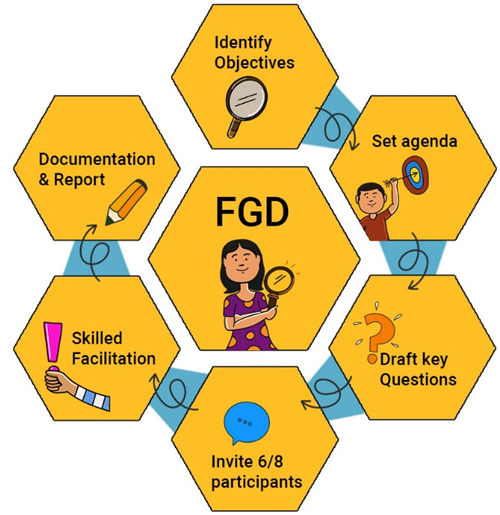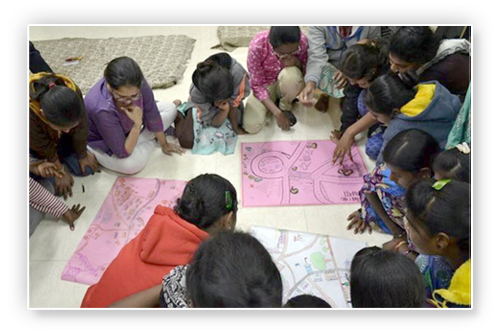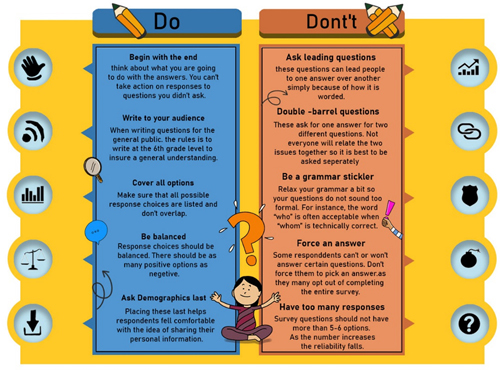
Community Research
Objectives - In this section, you will learn:
- The process of fieldwork in Action Research
- To plan data collection methods and design tools
- To reflect and learn from the field- with examples from YAR Partners
Fieldwork is the most interesting, enjoyable, and yet the most challenging part of the action research. Interacting with people and listening to their stories can be an enriching experience. Moreover, stories connect people. Such stories bring insights, inspiration, and ideas. One requires patience, understanding, and empathetic listening skills to make participants feel comfortable and trusted enough to share their stories with you.
However, not all interactions are easy. In some instances and contexts, interacting with community members and the authorities can be very difficult. Therefore, a good understanding of one’s research subject, ethical protocols, and practice of asking questions are essential for all the members. Practice sessions and pilot testing before actual data collection are useful in this regard.
Data collection tools are crucial to collect insights, information, and narratives from the people. Survey Questionnaire is a typical quantitative tool that can gather large amounts of information in less time, while interview and focus group discussions (FGD) are best suited for collecting qualitative data.
We believe that qualitative and quantitative methods are complementary to each other. While it is crucial to study the trend and patterns, it is necessary to understand and document nuanced, deeper experiences of an individual. In research, numbers (quantitative methods) can point out what is happening in society but only narratives (qualitative methods) can explain why it is happening. For example, a survey may be the best way to study the prevalence of violence against women, but in-depth interviews are necessary to fully understand women’s experiences.
YAR partners used mixed methods which included census, in-depth surveys, FGD, and community maps. The use of more than two methods was a strategic choice that resulted in gathering complex (often contradictory) and layered data.
At some places, creative and engaging tools were also used. Theatre techniques, for instance, were used by the YAR partners in the Philippines to reduce hesitance, and break barriers between participants and researchers. The experiment was very successful, the team reported enhanced rapport and trust in their communities.
Youth ownership is the uniqueness and also the strength of the YAR initiative. The young women and girls who were living in the local communities led the research process, the research topics were inspired by their own lived realities, and the, research design and methods were chosen by them. As a result, they had the maximum clarity of purpose and process of the study they had undertaken.
Many of the young researchers reported that they felt empowered through this process. Young girls and women were recognized at home, school/community, and at the village as a researcher which made them feel significant and respected.
YAR partners used the following data collection methods:
Census
Census is a systematic procedure (mostly in survey format) to acquire household/demographic information from every participant available. Government departments mostly use this method where a large amount of information is required to draft schemes, policies and suggest changes, etc. Census is well known for its ability to gather large numbers which help to understand patterns, it is obvious that when more and more data are collected, the quality and accuracy of results increases.
Young researchers from India conducted a census of the girls and their families to gather basic information of their demographics, this helped them understand the context of girls in the villages and their socioeconomic situation at large.
In-depth survey
Survey is the most popular and widely used method which gathers a large amount of information in less time. An in-depth survey can provide detailed insights into the respondents' thoughts, feelings, and behaviours. The survey is a both quantitative and qualitative method where the same sets of questions are asked to randomly selected representative respondents from the population.
Surveys can be long or short, depending on the subject of the study and the respondents. Most of the surveys are conducted in person, but sometimes they can be administered through telephone, email, or online (google forms, chimp surveys, etc.). It is advisable to keep survey forms simpler and accessible for both, the young researchers as well as the respondents.
Open-ended questions which aim to generate more detailed answers are crucial. Such narrative answers open myriad patterns of connections and also bring richness to the discussion and analysis of the problem.
Although conducting surveys may be relatively easy, designing those survey forms (called a questionnaire) is the most challenging task. All the questions, their framing, words, sequence, and tone needs to be carefully looked at. The tips and experience shared here will help one to draft a questionnaire wisely.
All the YAR partners designed their questionnaire carefully, discussed, edited and piloted it a couple of times before arriving at the final draft. The final questionnaire was then used for all the data collection processes. All the young researchers were involved in this process so that they learn from this practice and use this experience in the analysis phase too. Since all the girls were from the communities, they could empathize with target respondents easily, therefore, they brought lots of insights to the questions and the analysis process. It also helped to break the binary between researchers and researched. The subjective experiences of the researchers helped the data collection and analysis process in many meaningful ways.
Focus Group Discussion (FGD)

A focus group discussion (FGD) is an excellent way to gather multiple perspectives on the same topic. A moderator/facilitator helps the group to have an honest and spontaneous discussion on the various aspects of a given topic, which in a way generates insights on group views & behaviour.
The strength and uniqueness of the FGD are that the participants can feel comfortable to agree or disagree on the given topic, able to express their concerns and justify their positions. Such kind of qualitative data is highly significant especially to unpack complex issues which numbers cannot explain. Action research is specifically interested to study the nuances of grassroots realities, including its contradictions, inconsistencies, and the full range of variations in terms of views, beliefs, practices, and experiences. Therefore, this method is apt for such studies.
However, FGD is not an easy method, a systematic FGD requires careful planning, thoughtful questions, and excellent facilitation & documentation skills.
Facilitation is the key to the success of any FGD. A person who is steering the conversation needs to be skilled, sensitive, and experienced in handling the group. She should ensure each participant can freely contribute, understand questions properly and feel comfortable expressing their disagreement, etc. A facilitator needs to be calm, approachable, and sensitive to socio-cultural diversity throughout the process. It is also advisable that the facilitator asks experienced notetakers to attend the whole session and document it carefully. She should also note down her observations and other notes apart from discussions in the session. Producing a detailed document promptly is important too.
Community Mapping

A map is a symbolic representation of selected characteristics of a place, for instance, they show locations of houses, streets, resources, and their distribution in a community. Maps are a simple, creative, and easy way to represent information visually. Historically, community asset mapping has been used in rural appraisal processes for the community empowerment process. It’s a powerful tool for understanding community resources and their distribution.
YAR partners also used maps for visually representing their community information. Creating a map not only helps to gather critical information about communities but also empowers the researchers in the process. Here is an inspiring story of young women researchers from rural India.
The Shodhinis of Kochargaon village is in a fix. They have just been to the Gram Panchayat (village headquarters) office to ask for a map of their village, and have been told that there is no map! Their village has no map, how can that be possible? Well, there’s only one thing left to be done. Sonali says decisively. We shall make our map, based on our observation. It will be the first and only map of Kochargaon! Early next morning, the Shodhinis meet at Sonali’s house. They pack some food and set off for a nearby hill. From this hill, the girls can get a bird’s eye-view of the entire village. They are not equipped with a camera, nor any high-class survey instruments. Just their eyes and a sense about their own village! After drawing some rough sketches, they go back down and roam through the entire village to understand where each building is located in relation to others. They collaborate by taking notes of different parts of the village, which are then discussed in the big group. Finally, in the afternoon, they take shelter in Sonali’s house once again and draw the final map. It takes a long time, but finally, it is done! Every Shodhini has contributed to its creation, even in the drawing and colouring of the map. They have even made a small index with special icons for important buildings of the village, such as the gram panchayat, the school, the water-tank, wells, the post office, and their own houses! You know, it looks like a fish, Kaushalya remarks, observing the map. The other girls laugh. No, it doesn’t! counters Tai. It looks more like a leaf because of the green farms. Girls! I think it looks like… A map! Our very own map! Manisha says happily. We should take this to the Panchayat office and show it to the Sarpanch, Sonali tells the girls. We shall tell him, see, we girls did what you and your officers could not do for so many years! We helped this village! The other Shodhinis agrees. They are all proud of creating something new for their village.
Research ethics are the moral guidelines/a set of rules that govern the quality and ethical procedures when one undertakes research. Following are the few Dos and Don’ts when you embark on the research journey.
- Respect for participants – A researcher must always show respect to their participants, it includes not judging them, not discrediting them, and ensuring that their views are fully recorded and included. The researcher should be socially aware and sensitiszed and ensures the participation of persons who are marginalized or vulnerable.
- No harm to participants – It is a fundamental principle that says no harm must come to participants as a result of their participation in the research. The participant should not be exposed to risk during and after the research process, and they must be informed about the entire research process through an informed consent. Sometimes, participation in social research may bring about emotional distress. The researcher must ensure that the participant is not left alone in such a state and referral, follow-up assistance, or counselling is arranged with experts wherever possible.
- Informed consent – Participants must have a free choice and they should be fully informed about their rights, the research process and any potential threats or risks. It is usually expected that informed consent is recorded in writing (as signed consent forms).
- Permission required for audio/video recording – If the researcher wants to audio/video record/photograph any participant, their specific approval for this must be received in advance. It is also significant to note that if the participants later request not using these materials, researchers must obey the request.
- Right to withdraw – Consistent with the principle of voluntary participation, participants are informed that they can withdraw their participation at any given time.
- Avoidance of undue intrusion – Researchers should only ask what is required and in the scope of their research study. Respect for the personal lives of the participants is essential.
- Anonymity and Confidentiality –People participate in research on the presumption that they will be anonymous and their information will be protected and kept confidential. When information is entrusted to a researcher in confidence, such confidentiality must be protected.
- Data protection – Data must be stored safely and securely and used only for research purposes.

